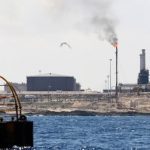An armed faction entered two major Libyan oil ports on Friday, pushing back forces that captured and reopened the terminals in September, officials and residents said.
The move risks increasing the fighting around the ports and casts new doubt over Libya‘s attempt to revive its oil production. The terminals at Es Sider and Ras Lanuf are two of Libya‘s largest, with potential combined production capacity of about 600,000 barrels per day (bpd).
It was unclear late on Friday to what extent the faction that attacked, the Benghazi Defence Brigades (BDB), had gained control over the area. There was no statement from the Libyan National Oil Corporation (NOC) in Tripoli, which restarted operations at the ports after the eastern-based Libyan National Army (LNA) took them over seven months ago.
Since then the LNA’s opponents have launched several unsuccessful attacks against the ports in Libya‘s eastern Oil Crescent, in a campaign linked to a broader conflict between factions based in eastern and western Libya.
The LNA had said the ports were well secured. But it said the BDB had launched a rapid, three-pronged attack early on Friday that pierced its defences.
Air strikes repelled an attack targeting a third port, Brega, but the LNA withdrew men and equipment around Es Sider and Ras Lanuf to avoid a damaging fire fight, LNA spokesman Ahmed al-Mismari said.
Port engineers, oil sources and residents said the BDB entered both Es Sider and Ras Lanuf ports after the attack.
The BDB posted pictures of its fighters at Ras Lanuf’s nearby air strip, though the LNA later said it had retaken control there.
At least nine men loyal to the LNA were killed and eight wounded in the fighting, a medical source said.
The LNA took Es Sider, Ras Lanuf, Brega and Zueitina oil ports in September. All but Brega had long been blockaded. After the NOC reopened them, Libya‘s oil production more than doubled.
The Benghazi Defence Brigades are composed partly of fighters who were ousted from Benghazi by the LNA, where LNA commander Khalifa Haftar has been waging a military campaign for nearly three years against Islamists and other opponents.
The LNA brands its opponents as Islamist extremists, and each side accuses the other of using mercenaries from Libya‘s sub-Saharan neighbours. Some in the east also accuse elements of the U.N.-backed Government of National Accord (GNA) in Tripoli of backing the BDB and their allies.
The GNA’s leadership strongly condemned Friday’s escalation, saying in a statement that it “did not give any order to any forces to move towards that area”. It suggested the attack could be an effort to scupper Libyan and international efforts to bring peace.
Libya has recently been producing about 700,000 barrels per day (bpd) of oil, more than double its output early last year but still far less than the 1.6 million bpd the OPEC member was pumping before the 2011 uprising.
The Oil Crescent ports suffered major damage in previous rounds of fighting and are still operating well below capacity.
Tankers have been loading at Es Sider since December, with the Amalthea due to arrive on March 7 to load 630,000 barrels for Austria’s OMV, according to shipping sources.
The NOC has been lobbying foreign firms to return to Libya and invest in the oil and gas sector as it tries to push production to 1.2 million bpd later this ye











